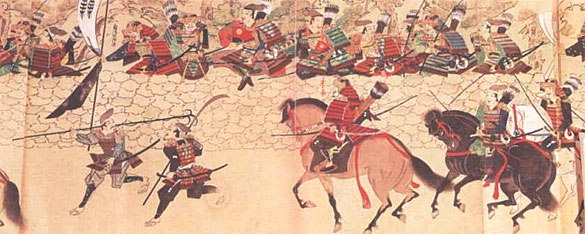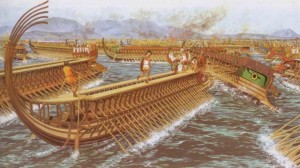Five Great Historical Battles (Blog Series)
July 25, 2012 in General Topics
 Today, I’m sharing the first of five historical battles that stand out, from my perspective, as exceptional for their scope, impact on history, and flat-out epic combat. If you’re getting the impression that your humble author is a student of history, you’re definitely following the right trench.
Today, I’m sharing the first of five historical battles that stand out, from my perspective, as exceptional for their scope, impact on history, and flat-out epic combat. If you’re getting the impression that your humble author is a student of history, you’re definitely following the right trench.
Fix bayonets. Here we go.
The Mongol Invasions of Japan – AD 1274, AD 1281
It’s been said that the Steppe is very much like an ocean of grass. In this environment, the rise of a supremely mobile force like the Golden Horde was almost inevitable. Long without a centralized leader — in part due to deliberate gamesmanship by China — the Mongolians finally united under Genghis Khan.
A host of historians and commentators, including the rather astute Dan Carlin, claim that Genghis is history’s greatest military leader. No matter one’s opinion on that stance, one thing can be said about this icon: he didn’t do anything halfway. As a stark example of his cold attention to detail, consider his tomb: located somewhere in the Steppe, it remains undiscovered, as the entire funeral procession was executed once he was buried.
That’s one way to make sure your tomb doesn’t get robbed. I digress.
Decades later, Kublai Khan became interested in adding Japan to the ever-growing list of Khanate holdings. He politely asked for Japanese fealty to his kindgom. This correspondence was conducted via a series of letters that were really thinly-veiled threats.
The island power didn’t capitulate, so Kublai launched massive fleets across the Sea of Japan, twice, in AD 1274 and AD 1281. Mongolian and Korean troops landed on Japanese shores and came face to face with the legendary Samurai.
I don’t have to tell you how incredible it would have been to witness battles between history’s greatest cavalry force, and some of its most implacable warriors. Tantalizing Japanese art from the period vividly depicts the many battles:
The Horde was defeated both times, and notably took steep losses on the second crossing due to storms. These invasions would have huge ramifications for the Far East. The successful repulsion of not one, but two Mongolian campaigns became a point of cultural pride for the Japanese people, as it should have.
In additon, a Japan that witnessed the nigh-miraculous decimation of the Khanate fleet by storms would inscribe in its natural mythos the legend of the “divine wind”. Unbroken by the Mongols, the Japanese Empire would be left free to take part in determining its own actions and responses to the often-fluid nature of power exchange in the region over the next several centuries. And one day, it would launch invasions of its own.
The Battle of Salamis – September 480 BC
Often overshadowed by the heroic last-stand undertaken by the alliance of Greek city-states at Thermopylae, the naval battle at the straits of Salamis was actually much more important to the outcome of the Greco-Persian Wars.
Xerxes I of Persia was attempting to finish what his equally-megalomaniacal father, Darius I, had tried to do from 492 onward. The planned Persian conquest of the Greek city-states was a family affair, in a sense. Xerxes I had planned for the second invasion of the remaining free Greek holdings for several years, and had amassed vast numbers of troops and ships.
It was a dark time for the Allies. Athens had been taken. Civilians were being evacuated from cities in the path of the Persian forces. And the Greeks were badly outnumbered. Though temporarily held back at Thermopylae and Artemisium, these earlier battles should be regarded as delaying actions and not the decisive fight the allied Greek city-states — and Xerxes — kept hoping for.
Withdrawing, the Greeks and their Athenian general, Themistocles, looked for a way to lure Xerxes into a fight where their numerical disadvantage could be nullified, and the renowned seamanship of the Persians would be a non-factor. In a sense, what they needed was the naval equivalent of Thermopylae, but on a much greater scale. They needed the Persians to fall prey to a choke point that would kill their ability to wage war with their strengths at hand.
Enter Salamis Island. The Greeks held up past the relatively-narrow nearby straits, and waited.
Embarking on what many historians believe was a clever misinformation campaign, they successfully sold Xerxes the notion that the Athenian contingent of the fleet was interested in giving up. Xerxes sailed his fleet into the straits of Salamis to block any chance for the would-be remaining enemy ships to escape, and had a throne set up overlooking the coming conflict.
Even better for the Allies and their triremes, the Persians didn’t move to block the straits until daybreak. Military historians can tell you that time allocated for deployment and preparation matters — and the Allies had it in spades. They spent all of the prior night preparing.
What happened next is open to some conjecture, but the general opinion of historians is that the Greek fleet pounced on the Persian forces before they were organized, launching ramming attacks and boarding actions. With no room to maneuver, the Persian ships fell victim to their own numbers. Second and third lines of ships became fowled-up amongst each other. Ships ran aground. The Greeks even launched a wedge attack through the center of the Persian line, splitting Xerxes’ forces:
At this point, your humble author would have loved to see the King’s face.
The fallout to this debacle was the undoing of the Persian attempts on Greek cities. From this point onward, much like after the Battle of Kursk in WWII (which we’ll discuss in a future post), the order of war would be changed. Now the Greeks would be dictating the course of the conflict. Terrified of getting trapped on the Greek peninsula, Xerxes retreated to his homeland and left a commander named Mardonius behind with various elite units at his disposal. This set the stage for the eventual Battles of Plataea and Mycale, where the Greeks emerged triumphant and crushed for good Persian ambitions in the region.
Greek pride rallied. Western civilization progressed free of Persian influence. Given that Greek ideas underpinned Europe (and eventually, the New World), the effect of the Battle of Salamis can be seen in virtually every corner of the western hemisphere.
Not bad for a confederation of squabbling city-states.
Keep an eye on this blog for part 2 of this series, coming in the very near future (Edit: See Part 2 right here). And check out “Paston, Kentucky”, in my currently-available short fiction collection, for some military sci-fi action.
Stay tuned.



Recent Discussion